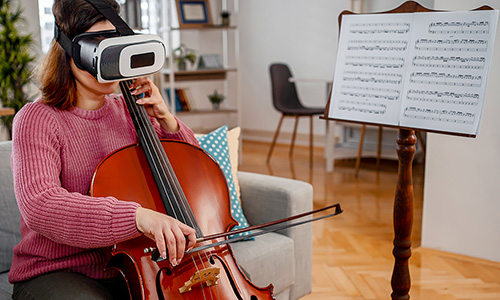The Metaverse and the Internet of Abilities
Want more free featured content?
Subscribe to Insights in Brief

The Internet of Abilities (IoA)—also, Internet of Skills—is a hypothetical future vision of the internet in which people can digitize and share physical skills and immersive experiences in the same way that they share content such as text, video, and images today. In a typical IoA vision, advanced sensing and recording technology enables people to capture detailed biometric data such as hand movements, point of gaze, skin temperature, and emotional states and similarly detailed data about environmental phenomena such as temperature, odors, and the locations, physical textures, and compositions of objects. Advanced user-interface technology such as augmented-reality (AR) and virtual-reality (VR) headsets, haptic gloves, and nerve stimulators can then re‑create the sensory experiences that the recording technologies captured.
Although aspects of the IoA vision have existed in research labs for decades, research interest in the IoA began to increase dramatically once advanced VR headsets began becoming widely available to consumers in 2016. The advent of widespread consumer VR technology—in combination with substantial advances in technology areas such as artificial intelligence and mobile communications—inspired researchers to imagine that a worldwide transition from the conventional internet to an IoA could be imminent. Consumer VR technology, rather than millions of dollars' worth of hardware and software, could enable enormous numbers of people to share experiences and skills with one another. For example, a skilled piano player could use a consumer VR device and haptic or neural hand controllers to record the immersive visual, auditory, tactile, and kinematic experience of playing a complicated piece of piano music and then share that experience on an IoA service in the same way that a person might upload a video of a similar piano performance today. Using a similar VR headset and haptic or neural controllers, any number of users could experience all the physical sensations that make up the experience of playing the piano piece. In this manner, the experience of skilled play—and the skill itself—becomes transferable from one human mind to another.
Such a transformation has not yet occurred; nevertheless, a noteworthy substantial overlap exists between visions of the IoA and visions of the metaverse—an immersive version of the internet that users ideally experience through VR and AR devices. The companies that are investing tens of billions of dollars to realize the vision of the metaverse have been spending money not just on developing advanced VR and AR devices and content-creation software for virtual worlds but also in developing the kinds of advanced haptic or neural-stimulation interfaces that could eventually enable users to record and play back tactile information. Although the metaverse has many potential uses other than enabling the immersive transference of experiences and skills (most emerging metaverse platforms focus on facilitating telework, socializing, entertainment, and gaming applications), user-to-;user experience and skill transfer could eventually become the killer app that inspires mainstream users to flock to the metaverse.
Like the metaverse, the IoA is at once a hypothetical future phenomenon and a real-world phenomenon that millions of people experience today. AR devices such as Microsoft's HoloLens already see limited but increasing use in industries such as manufacturing, medicine, and logistics. Although applications for such devices vary, skills training has been one of the most popular uses for AR and VR devices in the enterprise. For example, Proximie offers a solution that leverages lightweight AR headsets to enable surgeons to assist one another remotely during operations, delivering a simplified version of the kind of experience and skill transfer that is part of the IoA vision. Similarly, militaries have experimented with AR‑assisted, real-time skills transfer for tasks such as performing aircraft maintenance. Other types of immersive experience transfer that were once the subject of IoA experiments have gained popularity among niche consumer groups. For example, consumer drones that can supply immersive first-person video to VR headsets enable individuals to experience the world from the drone's perspective.
But like the metaverse, the IoA likely will have little societal impact unless and until it becomes ubiquitous. The internet began becoming widely available to businesses and consumers in the late 1980s, but it did not begin to transform society until nearly a decade later. Likewise, the metaverse and the IoA lack the critical mass of users necessary to create societally transformative network effects. Whether, when, and to what extent the metaverse—and thus the IoA—becomes ubiquitous is largely in the hands of the Big Tech companies that are spending tens of billions of dollars to develop consumer VR and AR technologies that are affordable and compelling.
Thus far, the kinds of devices that have gained traction with consumers lack the types of multisensory interfaces that exist in the IoA vision. For example, the VR devices in the Meta Quest line from Meta Platforms lack sophisticated haptic or neural controllers and instead rely on relatively simple handheld touch controllers that are similar to those that see use with video-game consoles. More-sophisticated haptic controllers are available for VR devices, but such controllers apparently have been too expensive and inconvenient to resonate with large numbers of users. In 2023, Apple will reportedly release its AR/VR device, which will likely use camera-based eye and hand tracking to eliminate any need for a physical controller. Without a physical controller, conveying tactile information to an end user may be impossible. If people enjoy the convenience of not needing to use a physical controller with Apple's device, other makers of AR and VR devices may also pursue controller-free interfaces. The ultimate result could be an IoA that is ubiquitous but lacks tactile immersiveness.